Fuel Cell Generator Market by End User (Marine, Aquaculture, Construction, Agriculture, Data Centers, Emergency Response Generators), Size (Small (Up to 200 kW), Large (>200 kW)), Fuel Type (Hydrogen, Ammonia, Methanol), Region - Global Forecast to 2030
[207 Pages Report] The global fuel cell generator market is projected to reach USD 2.1 billion by 2030 from an estimated USD 0.4 billion in 2023, at a CAGR of 25.4% during the forecast period. Recently regions has witnessed a rapid growth in fuel cell generator demand due to growing demand of hydrogen as a fuel for various end use applications.
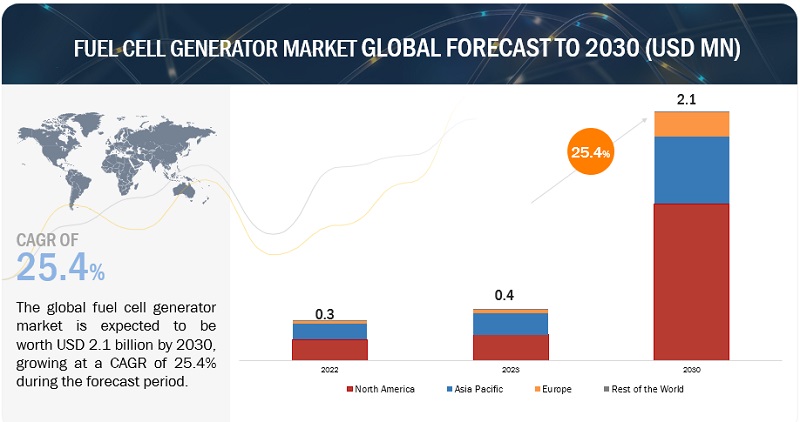
To know about the assumptions considered for the study, Request for Free Sample Report
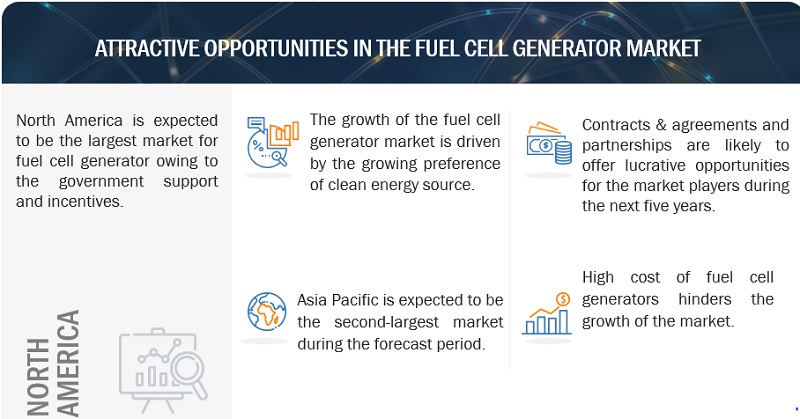
To know about the assumptions considered for the study, download the pdf brochure
Fuel cell generator Market Dynamics
Driver: Rising need for dependable and continuous power provision
The increasing demand for reliable and uninterrupted power supply serves as a significant driver for fuel cell generators. In today's modern society, a constant and dependable power supply is crucial for various sectors and applications, including residential, commercial, industrial, and critical infrastructure. Traditional power sources often face challenges such as grid instability, frequent outages, and limited capacity, which can disrupt operations and cause significant economic losses. Fuel cell generators offer a reliable alternative by providing a continuous and stable power source. With their ability to operate independently of the grid and provide power on-site, fuel cell generators ensure uninterrupted electricity supply, even in remote locations or during grid failures. This growing need for dependable power provision drives the adoption of fuel cell generators across diverse industries, ensuring uninterrupted operations, improved productivity, and enhanced reliability in power supply.
Restraint: High cost of catalysts used in fuel cell generators
The broad usage of this technology is severely constrained by the high cost of the catalysts used in fuel cell generators. In fuel cells, catalysts are essential for promoting the electrochemical reactions that turn fuel into electricity. However, the price of catalyst components, such platinum, is relatively high, which greatly raises the cost of fuel cell systems. Particularly when compared to other energy generation technologies, this cost component presents a hurdle for making fuel cell generators commercially feasible. To get beyond this limitation and increase the viability of fuel cell generators as an industry, it is important to find other, more affordable catalyst materials or to create more effective catalyst designs.
Opportunities: Increasing renewable energy grid integration
Increasing renewable energy grid integration presents a significant opportunity for the fuel cell generator market. As the share of renewable energy sources such as solar and wind power continues to grow, so does the need for effective energy storage and balancing solutions. Fuel cell generators can play a crucial role in this integration process. They can efficiently convert excess renewable energy into hydrogen through the process of electrolysis, storing it for later use. When there is a dip in renewable energy production, fuel cell generators can utilize the stored hydrogen to generate electricity, thereby ensuring a stable and reliable power supply. This ability to store and dispatch renewable energy on demand makes fuel cell generators an asset for enhancing the reliability and resilience of renewable energy systems. Furthermore, by enabling better utilization of intermittent renewables, fuel cell generators contribute to a more efficient and sustainable energy mix. As a result, the increasing integration of renewable energy sources provides a strong growth opportunity for the fuel cell generators market.
Challenges: High operational temperature of solid oxide fuel cells
The high operational temperature requirement of solid oxide fuel cells (SOFCs) presents a significant technical challenge in their practical implementation. SOFCs typically operate at temperatures above 600°C, which is significantly higher than other fuel cell technologies. This high temperature requirement poses several obstacles. Firstly, it necessitates the use of specialized and costly materials that can withstand extreme conditions, such as high-temperature ceramics and refractory metals. These materials need to exhibit excellent thermal stability, mechanical strength, and chemical resistance to ensure the longevity and reliability of the SOFC system. Secondly, managing and maintaining the high temperature within the fuel cell stack becomes crucial. Proper thermal management is essential to prevent thermal stresses, maintain uniform temperature distribution, and avoid localized hotspots that can lead to material degradation and reduced cell performance. Moreover, the high operating temperature increases the risk of thermal expansion mismatches and thermal cycling, which can accelerate component degradation and reduce the overall durability of the SOFC system. Addressing these challenges requires ongoing research and development efforts to optimize materials, design effective thermal management systems, and enhance the long-term stability and reliability of high-temperature SOFCs.
Fuel cell generator Market Ecosystem
Prominent companies in this market include well-established, financially stable manufacturers of Fuel cell generator systems and components. These companies have been operating in the market for several years and possess a diversified product portfolio, state-of-the-art technologies, and strong global sales and marketing networks. Prominent companies in this market include Bloom Energy (US), Doosan Fuel Cell Co., Ltd. (South Korea), Ballard Power Systems (Canada), ABB (Switzerland), Loop Energy Inc. (Canada).
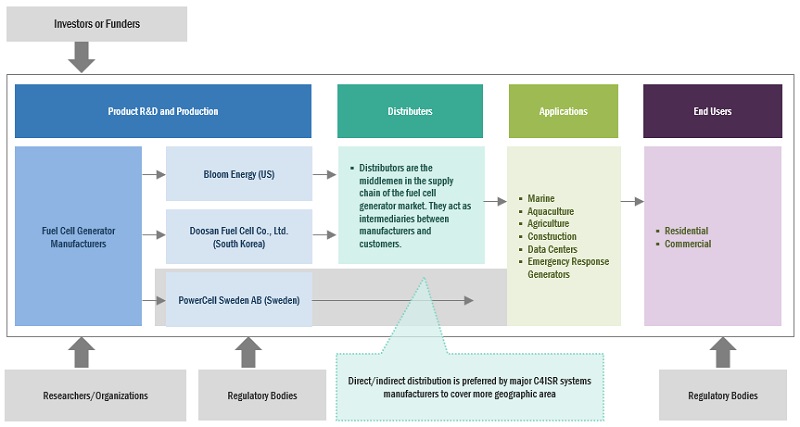
The ammonia segment, by fuel type, is expected to be the fastest growing market during the forecast period.
This report segments the fuel cell generator market based on fuel type into hydrogen, ammonia, methanol. ammonia is a high-energy-density carrier that can be easily stored, transported, and converted into hydrogen, which is the fuel source for many fuel cell technologies. By utilizing ammonia as a fuel, fuel cell generators can overcome some of the challenges associated with hydrogen storage and distribution.
By size, large scale (Above 200 kW) segment is expected to be the fastest growing during the forecast period
This report segments the fuel cell generator market based on size into two segments: small scale (up to 200 kW), and large scale (above 200 kW). The large-scale segment is expected to be the fastest growing segment during the forecast period. The increasing demand for decentralized power generation in industries such as data centers, manufacturing, and grid support requires higher power capacities that can be efficiently met by large-scale fuel cell systems.
“North America”: The largest in the fuel cell generator market”
North America is expected to be the largest region in the market in 2022, followed by the Asia Pacific, and Europe. The North American region witnessed an increase in government support through policies, incentives, and funding programs has encouraged the deployment of fuel cell technology.
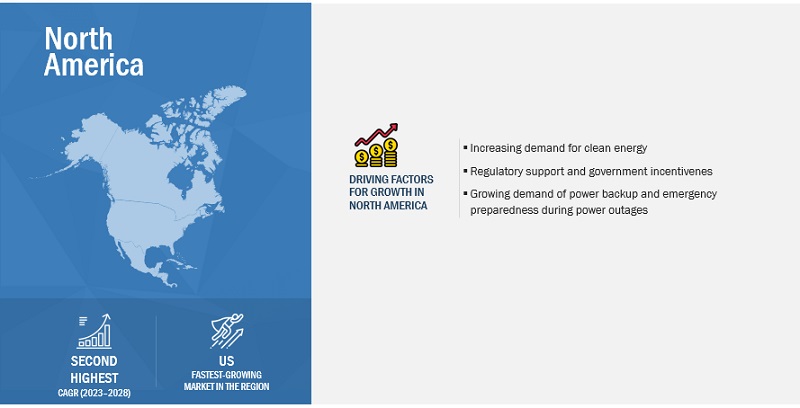
Key Market Players
The market is dominated by a few major players that have a wide regional presence. The major players in the fuel cell generator market include Bloom Energy (US), Doosan Fuel Cell Co., Ltd. (South Korea), Ballard Power Systems (Canada), ABB (Switzerland), and Loop Energy Inc. (Canada). Between 2018 and 2022, Strategies such as contracts, agreements, partnership, merger, acquisitions, and expansions are followed by these companies to capture a larger share of the market.
Get online access to the report on the World's First Market Intelligence Cloud
- Easy to Download Historical Data & Forecast Numbers
- Company Analysis Dashboard for high growth potential opportunities
- Research Analyst Access for customization & queries
- Competitor Analysis with Interactive dashboard
- Latest News, Updates & Trend analysis
Request Sample Scope of the Report
Get online access to the report on the World's First Market Intelligence Cloud
- Easy to Download Historical Data & Forecast Numbers
- Company Analysis Dashboard for high growth potential opportunities
- Research Analyst Access for customization & queries
- Competitor Analysis with Interactive dashboard
- Latest News, Updates & Trend analysis
|
Report Metric |
Details |
|
Market size available for years |
2020–2030 |
|
Base year considered |
2022 |
|
Forecast period |
2023–2030 |
|
Forecast units |
Value (USD Million/Billion); Volume (MW) |
|
Segments covered |
Fuel cell generator market by type, end user, size, fuel type, and region. |
|
Geographies covered |
Asia Pacific, North America, Europe, Rest of the World. |
|
Companies covered |
Bloom Energy (US), Doosan Fuel Cell Co., Ltd. (South Korea), Ballard Power Systems (Canada), ABB (Switzerland), Loop Energy Inc. (Canada), PowerCell Sweden AB (Sweden), Nedstack Fuel Cell Technology BV (Netherlands), Plug Power Inc. (US), TECO 2030 (Norway), ABB (Switzerland), Siemens Energy (Germany), Cummins Inc. (US), AFC Energy PLC (UK), Toshiba Energy Systems & Solutions Corporation (Tokyo), Proton Motor Power Systems PLC (UK), Panasonic Corporation (Japan), EODev (France), GenCell Ltd. (Israel), Fuji Electric Co., Ltd. (Japan), PowerUP Energy Technologies (Estonia), TW Horizon Fuel Cell Technologies (Singapore), Altergy (US), Freudenberg Sealing Technologies GmbH & Co. KG (Germany), BOC Limited (UK), H2SYS (France), GAUSSIN (France), YANMAR HOLDINGS CO., LTD (Japan), . |
This research report categorizes the market by type, end user, fuel type, size, and region.
On the basis of by type, the fuel cell generator market has been segmented as follows:
- Proton Exchange Membrane Fuel Cell (PEMFC)
- Alkaline Fuel Cell (AFC)
- Solid Oxide Fuel Cell (SOFC)
- Phosporic Acid Fuel Cell (PAFC)
On the basis of end user, the market has been segmented as follows:
- Marine
- Aquaculture
- Agriculture
- Construction
- Data Centers
- Emergency Response Generators
On the basis of size, the market has been segmented as follows:
- Small Scale (Up to 200 kW)
- Large Scale (Above 200 kW)
On the basis of fuel type, the market has been segmented as follows:
- Hydrogen
- Methanol
- Ammonia
On the basis of region, the market has been segmented as follows:
- Asia Pacific
- Europe
- North America
- Rest of the World
Recent Developments
- In June 2023, PowerCell Sweden AB has entered into a partnership with Robert Bosch GmbH to produce the S3 fuel cell stack for PowerCell. This collaboration enables PowerCell to considerably expand its production capacity while emphasizing the scaling up of fuel cell system assembly and deliveries. Additionally, PowerCell will concentrate on the development of the next generation of fuel cell stacks.
- In February 2023, Doosan Fuel Cell and the government of South Australia have entered into an agreement that encompasses several key areas of collaboration. The agreement involves the exchange of equipment and expertise to facilitate the production of environmentally friendly hydrogen and its derivatives. It also entails the development of strategies and partnerships to enhance global competitiveness in hydrogen exports. Additionally, the collaboration aims to secure research partnerships and projects that will accelerate future decarbonization efforts.
- In November 2022, Bloom Energy signed a contract with Aspire Bakeries for the installation of fuel cell in California. The bakery's project, initiated in 2019, aims to decrease reliance on the Los Angeles power grid by generating 75% of its electricity through on-site fuel cells. These fuel cells utilize an electrochemical process to convert natural gas into electrical energy, thereby reducing the bakery's demand from the grid.
Frequently Asked Questions (FAQ):
What is the current size of the fuel cell generator market?
The current market size of the fuel cell generator market is USD 0.3 billion in 2022.
What are the major drivers for the fuel cell generator market?
Increasing need for uninterrupted clean power will be major drivers for the fuel cell generator market.
Which is the largest region during the forecasted period in the fuel cell generator market?
North America is expected to dominate the fuel cell generator market between 2023–2030, followed by Asia Pacific and Europe. Increase demand of clean energy in the recent years are driving the market for this region.
Which is the largest segment, by end user during the forecasted period in the fuel cell generator market?
The data center segment is expected to be the largest market during the forecast period. Fuel cell generators have higher energy conversion efficiencies compared to traditional backup power systems, such as diesel generators. They can achieve efficiencies as high as 60%, while diesel generators typically operate at around 30-40% efficiency. The higher efficiency of fuel cells results in reduced energy consumption and lower operating costs for data centers, especially in scenarios where backup power is required for extended periods.
Which is the fastest segment, by fuel type during the forecasted period in the fuel cell generator market?
The ammonia segment is expected to be the fastest market during the forecast period. Ammonia is a stable compound that can be easily liquefied and stored at ambient temperature and pressure, making it a viable option for long-term energy storage applications
To speak to our analyst for a discussion on the above findings, click Speak to Analyst
The study involved major activities in estimating the current size of the fuel cell generator market. Exhaustive secondary research was done to collect information on the peer and parent markets. The next step was to validate these findings, assumptions, and sizing with industry experts across the value chain through primary research. Both top-down and bottom-up approaches were employed to estimate the complete market size. Thereafter, market breakdown and data triangulation were used to estimate the market size of the segments and subsegments.
Secondary Research
This research study on the fuel cell generators market involved the use of extensive secondary sources, directories, and databases, such as Hoovers, Bloomberg, Businessweek, Factiva, IMF, IEA, and US EIA, to identify and collect information useful for a technical, market-oriented, and commercial study of the market. The other secondary sources included press releases & investor presentations of companies, white papers, certified publications, articles by recognized authors, manufacturer associations, trade directories, and databases.
Primary Research
The fuel cell generator market comprises several stakeholders such as fuel cell generator manufacturers, manufacturing technology providers, and technical support providers in the supply chain. The demand side of this market is characterized by the rising demand for fuel cell generator in, generation, transmission, and distribution application. The supply side is characterized by rising demand for contracts from the industrial sector, and mergers & acquisitions among big players. Various primary sources from both the supply and demand sides of the market were interviewed to obtain qualitative and quantitative information. Following is the breakdown of primary respondents:
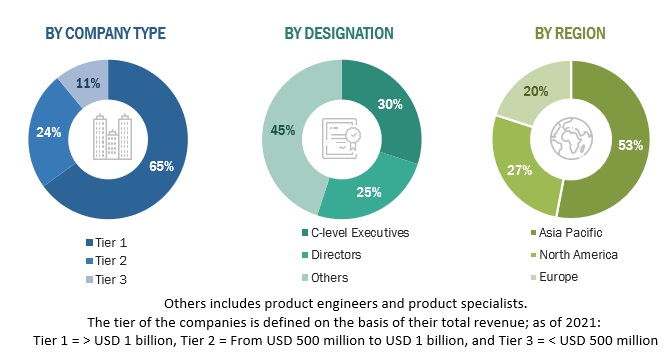
To know about the assumptions considered for the study, download the pdf brochure
Market Size Estimation
Both top-down and bottom-up approaches were used to estimate and validate the total size of the market. These methods were also used extensively to estimate the size of various subsegments in the market. The research methodology used to estimate the market size includes the following:
- The key players in the industry and market have been identified through extensive secondary research, and their market share in the respective regions have been determined through both primary and secondary research.
- The industry’s value chain and market size, in terms of value, have been determined through primary and secondary research processes.
- All percentage shares, splits, and breakdowns have been determined using secondary sources and verified through primary sources.
Fuel Cell Generator Market Size: Tow-Down Approach

To know about the assumptions considered for the study, Request for Free Sample Report
Data Triangulation
After arriving at the overall market size from the estimation process explained above, the total market has been split into several segments and subsegments. To complete the overall market engineering process and arrive at the exact statistics for all the segments and subsegments, the data triangulation and market breakdown processes have been employed, wherever applicable. The data has been triangulated by studying various factors and trends from both the demand- and supply sides. Along with this, the market has been validated using both the top-down and bottom-up approaches.
Market Defenition
Fuel cell generators (FCGs) are advanced energy devices that convert chemical energy from a fuel source, typically hydrogen, into electricity through an electrochemical process. These generators consist of various components, including an electrolyte, an anode, a cathode, and a catalyst. Additionally, FCG comprises fuel cell stacks and other balance of plant (BoP) system components such as a container, a power inverter, ultracapacitors, a cooling system, a fuel storage system, a system controller, and a data acquisition equipment.
The market growth is being driven by the increasing demand of clean energy, and the government initiatives to promote adoption of clean fuel.
Key Stakeholders
- Ceramic and electrolyte manufacturers
- Consulting companies in the energy & power sector
- Environmental research institutes
- Fuel cell and stack manufacturers
- Government and research organizations
- Institutional investors/shareholders
- Power and energy associations
- Repair and maintenance service providers
- Fuel cell technology manufacturing companies
- Organizations, forums, alliances, and associations
- Research and consulting companies in the clean energy generation sector
- State and national regulatory authorities
Objectives of the Study
- To define, describe, segment, and forecast the fuel cell generator market size, by end user and region, in terms of value and volume
- To forecast the market size across five key regions, namely North America, Europe, Asia Pacific, and Rest of the World (RoW), in terms of value
- To analyze the market using macro factors such as CO2 emissions level and the number of ships at the country level
- To describe three types of fuel cell technologies used in backup power generators—proton-exchange membrane fuel cell (PEMFC), solid oxide fuel cell (SOFC), and alkaline fuel cell (AFC)
- To provide detailed information about the key drivers, restraints, opportunities, and industry-specific challenges influencing the growth of the market
- To strategically analyze the fuel cell generators market with respect to individual growth trends, prospects, and contributions of each segment to the market
- To provide information pertaining to the supply chain, trends/disruptions impacting customer business, market map, pricing of fuel cell generators, and regulatory landscape pertaining to the market
- To strategically analyze the micromarkets1 with respect to individual growth trends, upcoming expansions, and their contributions to the overall market
- To analyze opportunities for stakeholders in the market and draw a competitive landscape for market players
- To benchmark players within the market using the company evaluation quadrant, which analyzes market players on various parameters within the broad categories of business and product strategies
- To compare key market players with respect to the market share, product specifications, and applications
- To strategically profile key players and comprehensively analyze their market ranking and core competencies2.
- To track and analyze competitive developments in the market, sales contracts, agreements, investments, expansions, product launches, alliances, mergers, partnerships, joint ventures, collaborations, and acquisitions.
Available Customizations:
With the given market data, MarketsandMarkets offers customizations according to the specific requirements of companies. The following customization options are available for the report:
Product Analysis
- Product Matrix, which provides a detailed comparison of the product portfolio of each company
Company Information
- Detailed analyses and profiling of additional market players




 Generating Response ...
Generating Response ...







Growth opportunities and latent adjacency in Fuel Cell Generator Market